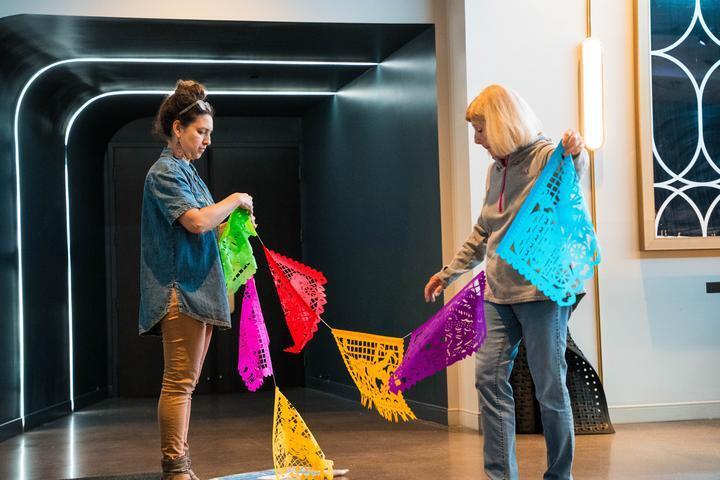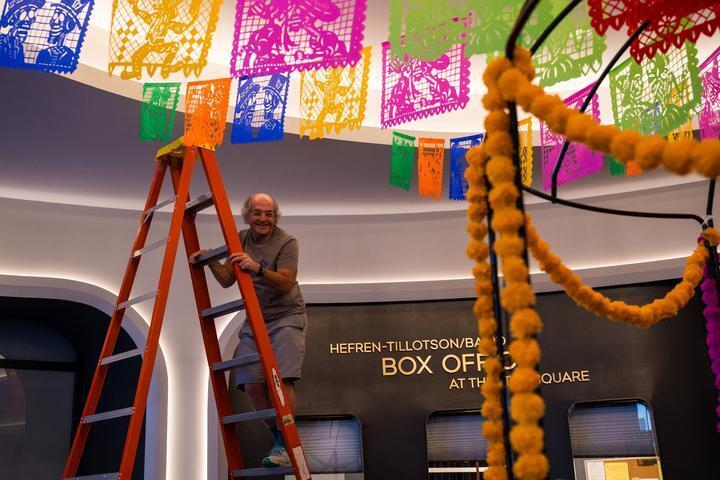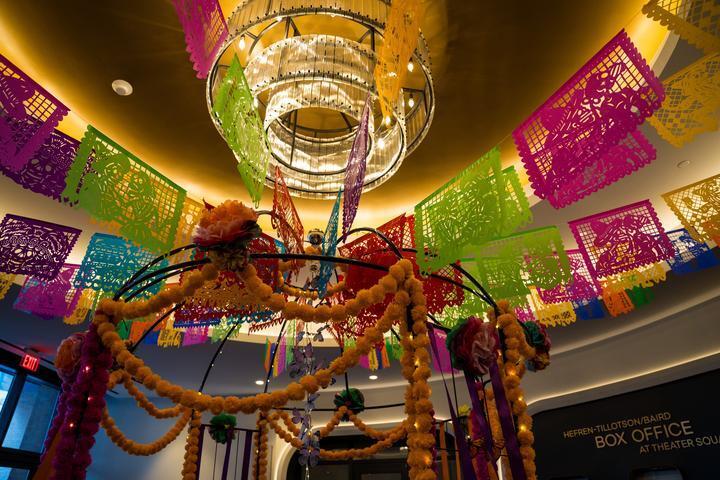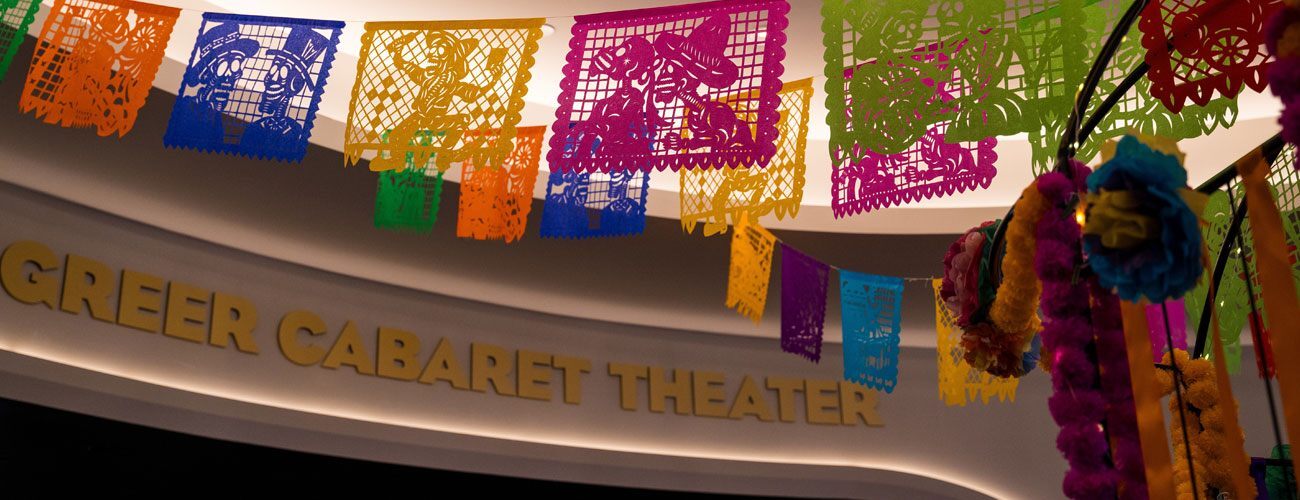Preparations are underway for the Cultural Trust’s second annual Día de los Muertos Celebration! From October 23 to November 2, join us in the Cultural District for a variety of entertaining and educational activities.
For the past few months, artists Alison Zapata and Lisa DiGioia-Nutini have been busy preparing for the Cultural Trust’s Día de los Muertos Celebration.
Under their creative guidance, the Kara Family Lobby in the Greer Cabaret Theater will soon be transformed with garlands of orange marigolds, skeletons, sugar skulls in vibrant shades, monarch butterflies, and more.
Together, these elements form the ofrenda—an altar created to honor and remember loved ones who have passed away.
Now in their second year of leading the process, the artists will once again work with Cultural Trust volunteers on installing the structure in the days before the celebration.
After that, it’s time for the ofrenda to grow. Over the course of the 11-day celebration, community members, including you, are invited to place their offerings on the altar, whether that be flowers, photos, letters, or other personal mementos.
Each item on the ofrenda tells a story. And the papel picado—those colorful strands of intricately cut paper squares that will be floating above your head—has a unique origin story of its own.

A Journey of Many Miles
Before last year’s celebration, the Trust commissioned a Mexican artist, Sergio Alejandro Martinez, to create Cultural Trust papel picado by hand.
Martinez follows the traditional process, using a chisel and other fine tools to carve detailed designs into stacks of tissue paper. He works with a plastic template to guide each precise cut.
After two or three days of careful craftsmanship, Martinez completed the commission and sent the papel picado from his hometown of Metepec, Mexico—approximately 2,340 miles away—to the Cultural District.
For Terri Bell, the Cultural Trust’s Vice President of Strategic Partnerships and Community Engagement, the whole process speaks to the authenticity of this celebration.
“Creating an ofrenda is such a rich, long-held tradition, and we wanted to honor that tradition by ensuring our ofrenda was rooted in authentic cultural practices,” she says. “We were honored to have Alison and Lisa create our ofrenda and guide us in the creative decisions of our 11-day celebration. We’re so grateful to have been introduced to Alejandro's work and to see so many community members engage with it.”
A Connection Through Happenstance
The team discovered Martinez and his work through DiGioia-Nutini, who has known the artist for more than 20 years and who also leads her own papel picado workshops. She was eager to relay the story of their unexpected meeting and the friendship that followed:
“My late husband and I found him quite by accident in the village of Metepec, in the state of Mexico. Metepec is actually most well-known for Arboles de la Vida, or Trees of Life, which is why we were there.
“Then we saw a small sign on a street corner made from papel picado and decided to investigate. We found Alejandro's father fast at work in a little workshop attached to their home. They made us feel quite welcome, and after seeing the glorious examples of their work hanging in the workshop, we of course asked if we could buy some for our store.
“He showed us the laborious techniques that he uses, which involve chisels, hammers and other small tools, cutting through hundreds of sheets of tissue paper at one time. Only someone known as a Gran Maestro (Great Master) can work in this way, as one small mistake would mean that you have ruined a great deal of paper!”

The Artist Behind the Craft
Martinez, who has been making papel picado since the age of 12, says he took up the tradition for three reasons:
“My motivation was Mexican culture, the colors of the paper, and above all, following in my father's footsteps in this noble craft.”
The part of the process he likes best is when he starts to draw. As this point, he explains, “It gives life to a piece of paper that initially contains nothing.”
Over the years, DiGioia-Nutini has worked with Alejandro on various commissions, including the Cultural Trust ofrenda.
“In this case, I asked Alejandro for his ‘standard Muerto theme,’ because I knew that it would be perfect from past experience,” she says. “It’s usually a combination of classic designs, like the famous ‘Catrina,’ which was originally done by engraver Jose Guadalupe Posada, mixed with designs of his own.”
Beyond individual commissions, DiGioia-Nutini adds, Alejandro’s work has been displayed in museums across the world, including his large-scale installations. He also participates in a traditional art form that uses flowers, seeds, and other organic material to beautify the frontispieces of church entrances.

Keeping the Tradition Alive
For DiGioia- Nutini and Martinez, creating papel picado isn’t only about making something beautiful. Given the advent of mass production techniques, it’s also about keeping the tradition alive.
Martinez says, “Machines (laser and die-cuts) are endangering traditional papel picado. This technique for which our ancestors gave their lives is now in danger of extinction. However, the few remaining artisans of 100% handmade papel picado will try to fight until the last day of our lives, defending it, this level of Mexican papel picado craft.”
When you visit the Cultural Trust ofrenda, we hope you not only appreciate the beauty of the papel picado, but also the importance of this special tradition and the people who uphold it.
